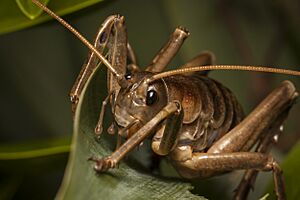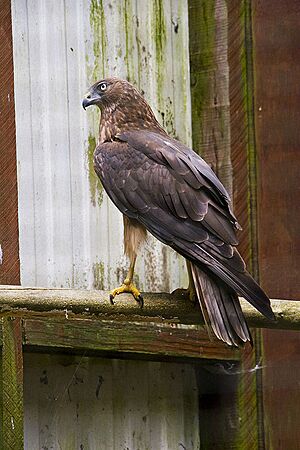Deinacrida fallai facts for kids
Quick facts for kids Deinacrida fallai |
|
|---|---|
 |
|
| Conservation status | |
| Scientific classification | |
| Genus: |
Deinacrida
|
| Species: |
fallai
|
The Poor Knights giant wētā (scientific name: Deinacrida fallai) is a super-sized insect found only on the Poor Knights Islands in New Zealand. These islands are off the northern coast. It's one of the biggest insects in the world!
This wētā can grow up to 73 mm (about 2.8 inches) long. Its huge size is an example of something called island gigantism. This happens when animals on islands grow much larger than their relatives on the mainland. The Poor Knights giant wētā is considered vulnerable by the IUCN. This is because it lives in a very small area.
Contents
What Does It Look Like?
The Poor Knights giant wētā was first described as a new species in 1950. It is the second largest wētā species in the world. Female wētā are much bigger than males. They can weigh up to 40 grams and measure up to 73 mm long.
These wētā are light brown with dark brown legs. They have black stripes along their sides. There's also a black line running down their back. Their bodies are wide, and they have rounded heads. They also have short mouthparts called mandibles.
The Poor Knights giant wētā mostly eats plants. They especially like kanuka and pohutukawa trees. Even though they eat plants, they might also eat other things. This means they are likely omnivores. For example, one wētā in a zoo was seen eating part of another type of wētā!
How Does It Behave?
Adult Poor Knights giant wētā move around a lot. They often go from one tree to another. They are mostly active at night. This is when they shed their skin, eat, and lay eggs. But they mate during the day.
They usually live alone. During the day, they sit quietly on tree branches. Even though they are big, they can move quickly. They can jump long distances up and down tree trunks. If something disturbs them, they can move fast. But their first reaction is usually to freeze. This helps them hide from predators that hunt by sight. Males are generally more aggressive than females. Males have been seen fighting other males during mating time.
When a Poor Knights giant wētā feels threatened, it raises its back legs high over its head. It also quickly moves its legs up and down. This makes a crackling or rasping sound. This scary display helps to scare away any animals that might want to eat them.
Young wētā, called nymphs, have a special way to protect themselves. They burrow headfirst into the soil. They leave only their back legs sticking out.
Where Does It Live?
The Poor Knights giant wētā lives only on the Poor Knights Islands. These islands are free of rats. They are common on the two biggest islands, Aorangi and Tawhiti Rahi. Signs of their presence have also been found on Archway Island. However, no wētā have been officially recorded there. They have not been found on any other nearby islands or on the main island of New Zealand.
These wētā live in forests. They spend most of their time on tree trunks and branches at night. During the day, they rest in leaves or hide under loose bark on pohutukawa trees. They do well in the untouched pohutukawa forests on these islands. They share their home with Tuatara, which are also unique New Zealand reptiles. Even though they mostly live in trees, they do go to the ground to lay eggs. They have even been found under stones in the forest.
Life Cycle
The Poor Knights giant wētā lives for a little over two years. This includes the time from when it's an egg until it dies as an adult. An adult female can live for up to nine months.
Eggs and Growth
Female wētā can lay eggs throughout their lives. They can lay eggs at any time of the year if the temperature is above 10°C. They lay eggs in the soil at night. They stand on their tiptoes and push a special egg-laying tube, called an ovipositor, into the ground.
They lay eggs close together, either one at a time or in small groups of up to five. A female can lay between 200 and 300 eggs in her lifetime. The number of eggs depends on how good the conditions are. Eggs are bright yellow when they are forming. They turn medium brown when they are laid. They are oval-shaped, about 2.5 mm wide and 7 mm long when first laid. They grow a bit bigger during incubation. The eggs take about five months (147 days) to hatch.
As they grow, the wētā go through 10 nymph stages. The ovipositor, which is used for laying eggs, can be seen when they reach their third nymph stage. Males and females start to look different in size at the sixth nymph stage. The time they spend in each nymph stage can vary a lot, from 3 to 13 weeks. Nymphs that hatch in summer or spring become adults about 11 to 13 months later.
How Do They Make Sound?
The Poor Knights giant wētā makes sounds by rubbing its back legs against its body. This is called stridulation. They have special parts on their legs and abdomen that rub together. When they move their back legs up and down, it makes a crackling or rasping sound. This loud noise is a strong warning to any animals that might want to eat them.
They also have another way to make sound. There are small spines between two parts of their abdomen. When the wētā is annoyed, it tightens its body muscles. This makes the spines rub together, creating a hissing sound. These sounds are only used when the wētā needs to defend itself.
Who Are Their Relatives?
The Poor Knights giant wētā is closely related to two other wētā species from northern New Zealand. These are D. heteracantha and D. mahoenui. Scientists figured this out by studying their genes and body features.
What Threats Do They Face?

Right now, there's no sign that the number of Poor Knights giant wētā is going down. However, many animals prey on them. Native predators include lizards, birds, and tuataras. Parts of wētā have been found in the stomachs of Swamp Harriers. These birds hunt during the day. This shows that the wētā can be caught during the day. The harrier hawk is a main daytime predator.
Even though these native predators don't seem to harm the wētā populations too much, it's important to be careful. We must make sure that no new animals that eat insects are brought to the islands. This could really hurt the wētā populations.
How Are They Protected?
The Poor Knights giant wētā is one of many giant wētā species that are protected by law in New Zealand. They are part of a plan by the Department of Conservation to help threatened wētā recover.
There is a special plan to keep pests away from the Poor Knights Islands. This is especially important for rodents like rats. If rats accidentally got onto the islands, they could seriously harm or even wipe out the entire Poor Knights giant wētā species. Scientists are also looking into whether these wētā could be moved to other safe locations to help their numbers grow.
The Poor Knights giant wētā has been successfully bred in captivity at the Wellington Zoo in New Zealand. They are used there to teach people about these amazing insects.



